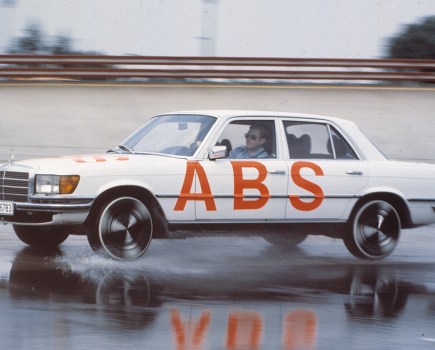What do the Plymouth Savoy and the Austin Montego have in common? At first glance, it’s hard to see the connection. When you factor heavy oil into the equation, the link is plain to see; both were sold with Perkins diesel engines. The former enjoyed a long and successful taxi career in mainland Europe, the latter revitalised the sales of a flagging and otherwise outdated model.
Cars were but one application Frank Perkins foresaw in the high-speed diesel engine; by the early ‘Thirties their fuel efficiency was well known, though performance lagged well behind that of contemporary petrol units (despite ever-increasing capacities).
Commercial and agricultural vehicles would be the main beneficiaries; their size made thrifty consumption of fuel all the more essential. As the world headed for a recession, small fast-running units represented the best of both worlds.
Undeterred, Frank Perkins set to work while employed by Aveling and Porter in Kent. Working with a precocious engine designer, Charles Chapman, the Vixen was born in 1932. In tests it ran at 4000rpm – a hitherto unheard of work rate for a small diesel unit. Perkins and Chapman went into business that year, running F. Perkins Limited from a small workshop in the centre of Peterborough. By 1933 a descendent, the Perkins ‘Wolf’, was powering a series of Albion and Commer trucks, many of which were converted from their original petrol specification. These transplants set a precedent; by the ‘Fifties, large American cars began arriving in Europe with Perkins oil-burners under the bonnet, supplanting the thirsty six- and eight-cylinder engines they left Detroit with.
Perkins had prospered during the Second World War, supplying air-sea rescue launches with engines. It now had thousands of employees on a new site just outside of Peterborough and could continue development into new designs. In the ‘Fifties, licensing deals to produce and modify its engines went worldwide. The decade would prove something of a golden age for Perkins; links with the Chrysler Corporation would prove lucrative for many years to come.
Where did this leave the private British motorist? Before the war intervened, few cars had diesel engines. Gardner units found their way into a few Lagondas and Freeman Saunders offered conversions for taxi cabs and motorcycles. For the most part, traditional diesels were unsuited to cars because of their slow-revving nature – they were simply too unrefined to offer any practical benefit other than fuel economy.
It therefore comes as no surprise that Perkins engines first found their way into cars via the taxi trade, where low running costs were paramount. The firm was able to apply its considerable expertise into building smaller capacity units – by 1956 the 1.6-litre ‘4.99’ was offered as an option under the bonnet of Beardmore-London cabs. That engine was too small for another group of European customers – the taxi companies that preferred large American cars for their carrying capacity and ride comfort.
Detroit’s straight-six and V8 engines were too thirsty for plying the streets –but Perkins had the answer in the form of the ‘P4C’, a high-revving (3000rpm) diesel engine designed specifically for car use. A 3.1-litre four-cylinder engine, the ‘P4C’ produced between 45hp and 60hp depending on specification. Diesel fuel was cheaper and far easier to come by than petrol in most European countries and although the ‘P4C’ was less powerful, its consumption in towns was far lower.
Although ‘P4C’-powered Nashes, Ramblers, Buicks and Dodges were soon racking up the miles, Plymouth’s Savoy became the most common recipient of Perkins’ engines, examples of which left Peterborough in their thousands.
Realising demand in Benelux and the Low Countries was strong. Hunter B.V. (Perkins’ Belgian agent) offered conversion sets for the ‘P4C’ and a large number of orders followed. Engines were transplanted in Chrysler’s factory in Antwerp from 1956 until 1959, the same year Perkins was acquired by its largest customer, Massey-Ferguson. The relationship with Chrysler lasted well into the ‘Seventies, with Perkins straight-six and V8 units powering large Chrysler buses and trucks. Auburn Hills planned another diesel engine with Perkins when it tried to compete with General Motors’ 5.7-litre V8, but the project, derived from the 2.2-litre four-cylinder used in the Omni and K-Car models, did not make it into production.
As the ‘Eighties neared, Perkins was approached by British Leyland for help in developing a new heavy oil unit based on its O Series petrol powerplant. Previously used in the Marina, Princess and Ital, the latter’s two-litre O Series was dieselised under the codename ‘Ferret’, which later spawned the Rover Mdi, or Perkins ‘Prima’. One of the first direct-injection diesel engines available in the UK, the Prima’s first outing was under the bonnet of the Austin Maestro van in 1986. Thanks to considerable development, an 80bhp turbocharged ‘Prima’ was available in a revised Montego for 1989, transforming the car’s standing in the press.
No other rival could offer 12,000-mile servicing intervals or 70,000-mile cambelt changes, making the Montego DSL – an early product of the now privately owned Rover Group – a highly prized fleet commodity. Sales rose sharply and diesel Montegos were sought-after long after the model died in 1995.
Consistently innovative and well-respected, Perkins survives today because of its engineering skill, adaptable engine designs and robust joint-venture arrangements. Its contributions to the wider British motor industry cannot be denied and the impact of the Prima changed the fledgling Rover Group for the better. Here’s to another 80 years.






